Business Law Assignment: Exploring Duty of Care & Negligence
VerifiedAdded on 2023/06/09
|7
|1373
|223
Report
AI Summary
This business law report examines the legal implications of negligence and duty of care, focusing on a scenario involving Sam, a fuel supplier, and three aircraft owners. The analysis employs the ILAC (Issues, Law, Application, Conclusion) method to determine Sam's liability in different situations. It considers tort law principles, including negligence, remoteness of damages, and available defenses like volenti non fit injuria and contributory negligence. The report concludes that Sam is liable for damages to White Ltd. due to direct negligence but not for the car accident. He is not liable to the passenger of Blue Ltd. as no duty of care existed. Finally, Sam is not liable to Green Ltd. due to the defense of voluntary assumption of risk by the pilot. Desklib offers similar solved assignments for students.
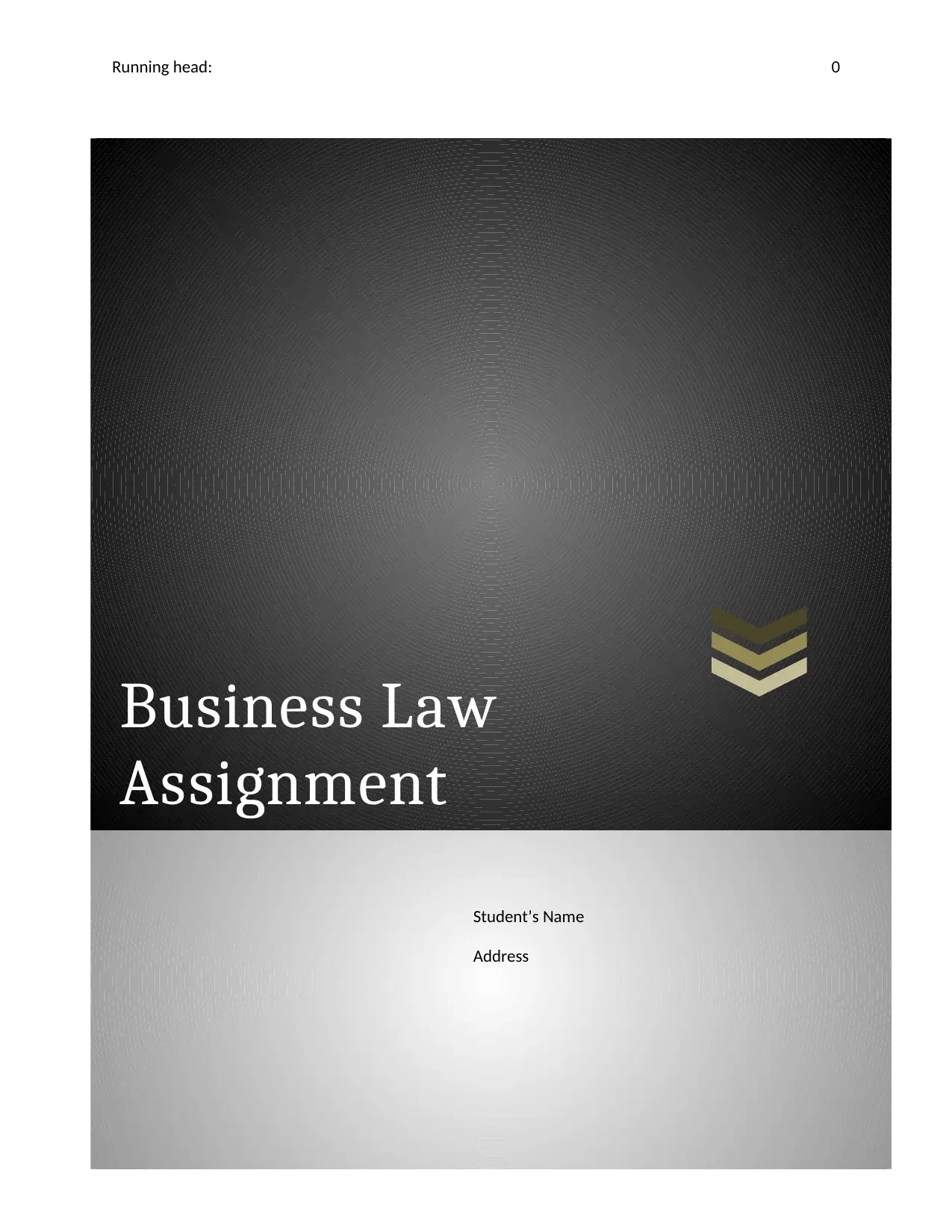
Business Law
Assignment
Running head: 0
Student’s Name
Address
Assignment
Running head: 0
Student’s Name
Address
Paraphrase This Document
Need a fresh take? Get an instant paraphrase of this document with our AI Paraphraser
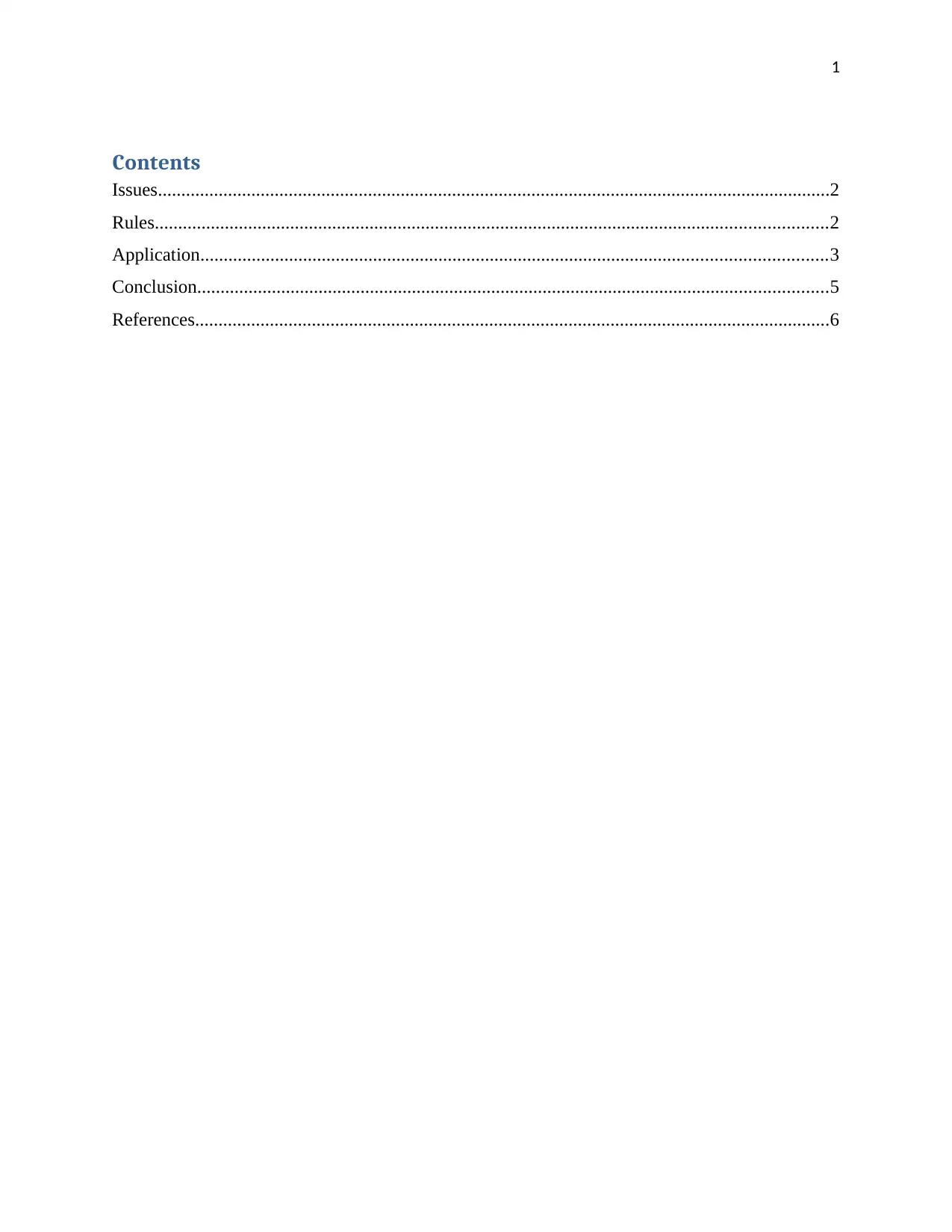
1
Contents
Issues................................................................................................................................................2
Rules................................................................................................................................................2
Application......................................................................................................................................3
Conclusion.......................................................................................................................................5
References........................................................................................................................................6
Contents
Issues................................................................................................................................................2
Rules................................................................................................................................................2
Application......................................................................................................................................3
Conclusion.......................................................................................................................................5
References........................................................................................................................................6
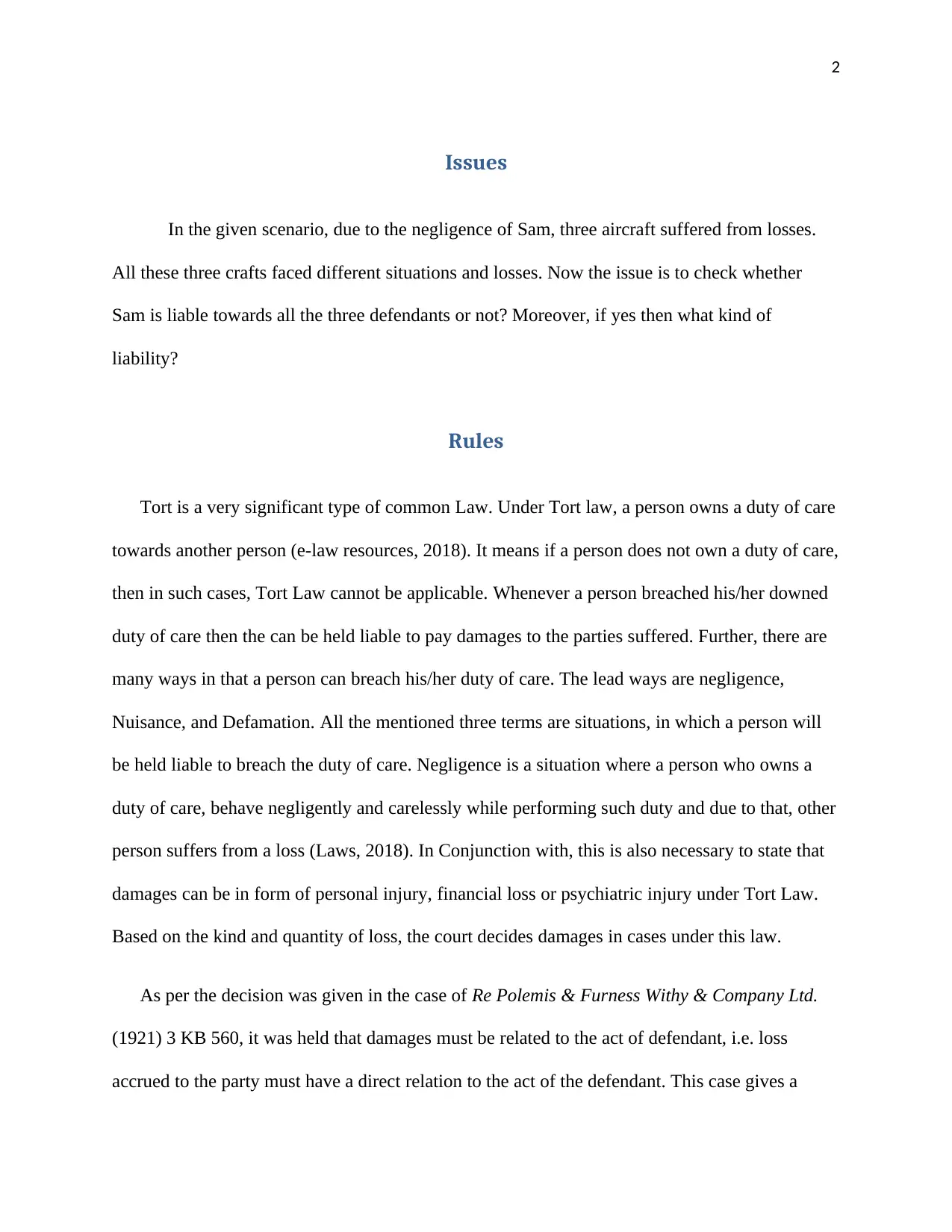
2
Issues
In the given scenario, due to the negligence of Sam, three aircraft suffered from losses.
All these three crafts faced different situations and losses. Now the issue is to check whether
Sam is liable towards all the three defendants or not? Moreover, if yes then what kind of
liability?
Rules
Tort is a very significant type of common Law. Under Tort law, a person owns a duty of care
towards another person (e-law resources, 2018). It means if a person does not own a duty of care,
then in such cases, Tort Law cannot be applicable. Whenever a person breached his/her downed
duty of care then the can be held liable to pay damages to the parties suffered. Further, there are
many ways in that a person can breach his/her duty of care. The lead ways are negligence,
Nuisance, and Defamation. All the mentioned three terms are situations, in which a person will
be held liable to breach the duty of care. Negligence is a situation where a person who owns a
duty of care, behave negligently and carelessly while performing such duty and due to that, other
person suffers from a loss (Laws, 2018). In Conjunction with, this is also necessary to state that
damages can be in form of personal injury, financial loss or psychiatric injury under Tort Law.
Based on the kind and quantity of loss, the court decides damages in cases under this law.
As per the decision was given in the case of Re Polemis & Furness Withy & Company Ltd.
(1921) 3 KB 560, it was held that damages must be related to the act of defendant, i.e. loss
accrued to the party must have a direct relation to the act of the defendant. This case gives a
Issues
In the given scenario, due to the negligence of Sam, three aircraft suffered from losses.
All these three crafts faced different situations and losses. Now the issue is to check whether
Sam is liable towards all the three defendants or not? Moreover, if yes then what kind of
liability?
Rules
Tort is a very significant type of common Law. Under Tort law, a person owns a duty of care
towards another person (e-law resources, 2018). It means if a person does not own a duty of care,
then in such cases, Tort Law cannot be applicable. Whenever a person breached his/her downed
duty of care then the can be held liable to pay damages to the parties suffered. Further, there are
many ways in that a person can breach his/her duty of care. The lead ways are negligence,
Nuisance, and Defamation. All the mentioned three terms are situations, in which a person will
be held liable to breach the duty of care. Negligence is a situation where a person who owns a
duty of care, behave negligently and carelessly while performing such duty and due to that, other
person suffers from a loss (Laws, 2018). In Conjunction with, this is also necessary to state that
damages can be in form of personal injury, financial loss or psychiatric injury under Tort Law.
Based on the kind and quantity of loss, the court decides damages in cases under this law.
As per the decision was given in the case of Re Polemis & Furness Withy & Company Ltd.
(1921) 3 KB 560, it was held that damages must be related to the act of defendant, i.e. loss
accrued to the party must have a direct relation to the act of the defendant. This case gives a
⊘ This is a preview!⊘
Do you want full access?
Subscribe today to unlock all pages.

Trusted by 1+ million students worldwide
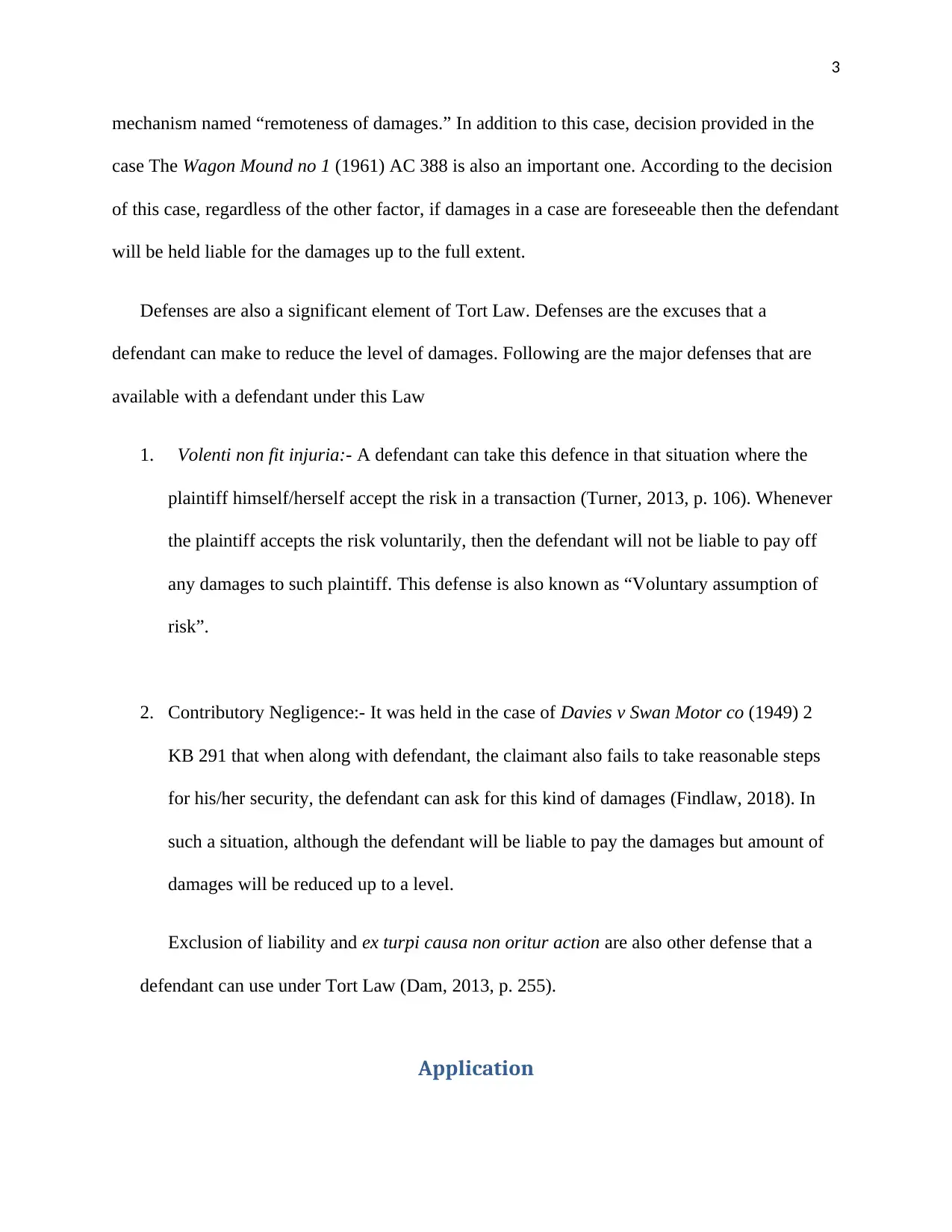
3
mechanism named “remoteness of damages.” In addition to this case, decision provided in the
case The Wagon Mound no 1 (1961) AC 388 is also an important one. According to the decision
of this case, regardless of the other factor, if damages in a case are foreseeable then the defendant
will be held liable for the damages up to the full extent.
Defenses are also a significant element of Tort Law. Defenses are the excuses that a
defendant can make to reduce the level of damages. Following are the major defenses that are
available with a defendant under this Law
1. Volenti non fit injuria:- A defendant can take this defence in that situation where the
plaintiff himself/herself accept the risk in a transaction (Turner, 2013, p. 106). Whenever
the plaintiff accepts the risk voluntarily, then the defendant will not be liable to pay off
any damages to such plaintiff. This defense is also known as “Voluntary assumption of
risk”.
2. Contributory Negligence:- It was held in the case of Davies v Swan Motor co (1949) 2
KB 291 that when along with defendant, the claimant also fails to take reasonable steps
for his/her security, the defendant can ask for this kind of damages (Findlaw, 2018). In
such a situation, although the defendant will be liable to pay the damages but amount of
damages will be reduced up to a level.
Exclusion of liability and ex turpi causa non oritur action are also other defense that a
defendant can use under Tort Law (Dam, 2013, p. 255).
Application
mechanism named “remoteness of damages.” In addition to this case, decision provided in the
case The Wagon Mound no 1 (1961) AC 388 is also an important one. According to the decision
of this case, regardless of the other factor, if damages in a case are foreseeable then the defendant
will be held liable for the damages up to the full extent.
Defenses are also a significant element of Tort Law. Defenses are the excuses that a
defendant can make to reduce the level of damages. Following are the major defenses that are
available with a defendant under this Law
1. Volenti non fit injuria:- A defendant can take this defence in that situation where the
plaintiff himself/herself accept the risk in a transaction (Turner, 2013, p. 106). Whenever
the plaintiff accepts the risk voluntarily, then the defendant will not be liable to pay off
any damages to such plaintiff. This defense is also known as “Voluntary assumption of
risk”.
2. Contributory Negligence:- It was held in the case of Davies v Swan Motor co (1949) 2
KB 291 that when along with defendant, the claimant also fails to take reasonable steps
for his/her security, the defendant can ask for this kind of damages (Findlaw, 2018). In
such a situation, although the defendant will be liable to pay the damages but amount of
damages will be reduced up to a level.
Exclusion of liability and ex turpi causa non oritur action are also other defense that a
defendant can use under Tort Law (Dam, 2013, p. 255).
Application
Paraphrase This Document
Need a fresh take? Get an instant paraphrase of this document with our AI Paraphraser
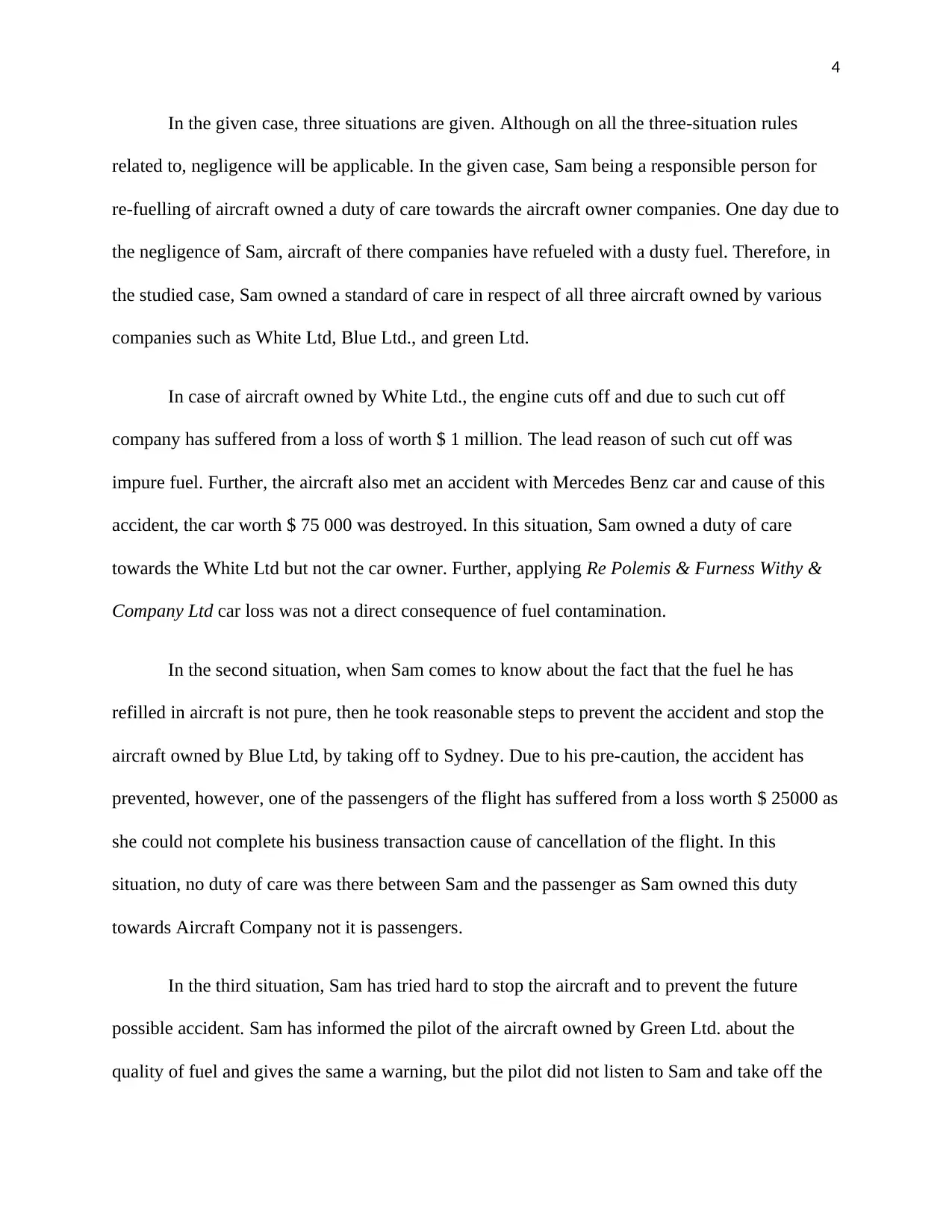
4
In the given case, three situations are given. Although on all the three-situation rules
related to, negligence will be applicable. In the given case, Sam being a responsible person for
re-fuelling of aircraft owned a duty of care towards the aircraft owner companies. One day due to
the negligence of Sam, aircraft of there companies have refueled with a dusty fuel. Therefore, in
the studied case, Sam owned a standard of care in respect of all three aircraft owned by various
companies such as White Ltd, Blue Ltd., and green Ltd.
In case of aircraft owned by White Ltd., the engine cuts off and due to such cut off
company has suffered from a loss of worth $ 1 million. The lead reason of such cut off was
impure fuel. Further, the aircraft also met an accident with Mercedes Benz car and cause of this
accident, the car worth $ 75 000 was destroyed. In this situation, Sam owned a duty of care
towards the White Ltd but not the car owner. Further, applying Re Polemis & Furness Withy &
Company Ltd car loss was not a direct consequence of fuel contamination.
In the second situation, when Sam comes to know about the fact that the fuel he has
refilled in aircraft is not pure, then he took reasonable steps to prevent the accident and stop the
aircraft owned by Blue Ltd, by taking off to Sydney. Due to his pre-caution, the accident has
prevented, however, one of the passengers of the flight has suffered from a loss worth $ 25000 as
she could not complete his business transaction cause of cancellation of the flight. In this
situation, no duty of care was there between Sam and the passenger as Sam owned this duty
towards Aircraft Company not it is passengers.
In the third situation, Sam has tried hard to stop the aircraft and to prevent the future
possible accident. Sam has informed the pilot of the aircraft owned by Green Ltd. about the
quality of fuel and gives the same a warning, but the pilot did not listen to Sam and take off the
In the given case, three situations are given. Although on all the three-situation rules
related to, negligence will be applicable. In the given case, Sam being a responsible person for
re-fuelling of aircraft owned a duty of care towards the aircraft owner companies. One day due to
the negligence of Sam, aircraft of there companies have refueled with a dusty fuel. Therefore, in
the studied case, Sam owned a standard of care in respect of all three aircraft owned by various
companies such as White Ltd, Blue Ltd., and green Ltd.
In case of aircraft owned by White Ltd., the engine cuts off and due to such cut off
company has suffered from a loss of worth $ 1 million. The lead reason of such cut off was
impure fuel. Further, the aircraft also met an accident with Mercedes Benz car and cause of this
accident, the car worth $ 75 000 was destroyed. In this situation, Sam owned a duty of care
towards the White Ltd but not the car owner. Further, applying Re Polemis & Furness Withy &
Company Ltd car loss was not a direct consequence of fuel contamination.
In the second situation, when Sam comes to know about the fact that the fuel he has
refilled in aircraft is not pure, then he took reasonable steps to prevent the accident and stop the
aircraft owned by Blue Ltd, by taking off to Sydney. Due to his pre-caution, the accident has
prevented, however, one of the passengers of the flight has suffered from a loss worth $ 25000 as
she could not complete his business transaction cause of cancellation of the flight. In this
situation, no duty of care was there between Sam and the passenger as Sam owned this duty
towards Aircraft Company not it is passengers.
In the third situation, Sam has tried hard to stop the aircraft and to prevent the future
possible accident. Sam has informed the pilot of the aircraft owned by Green Ltd. about the
quality of fuel and gives the same a warning, but the pilot did not listen to Sam and take off the
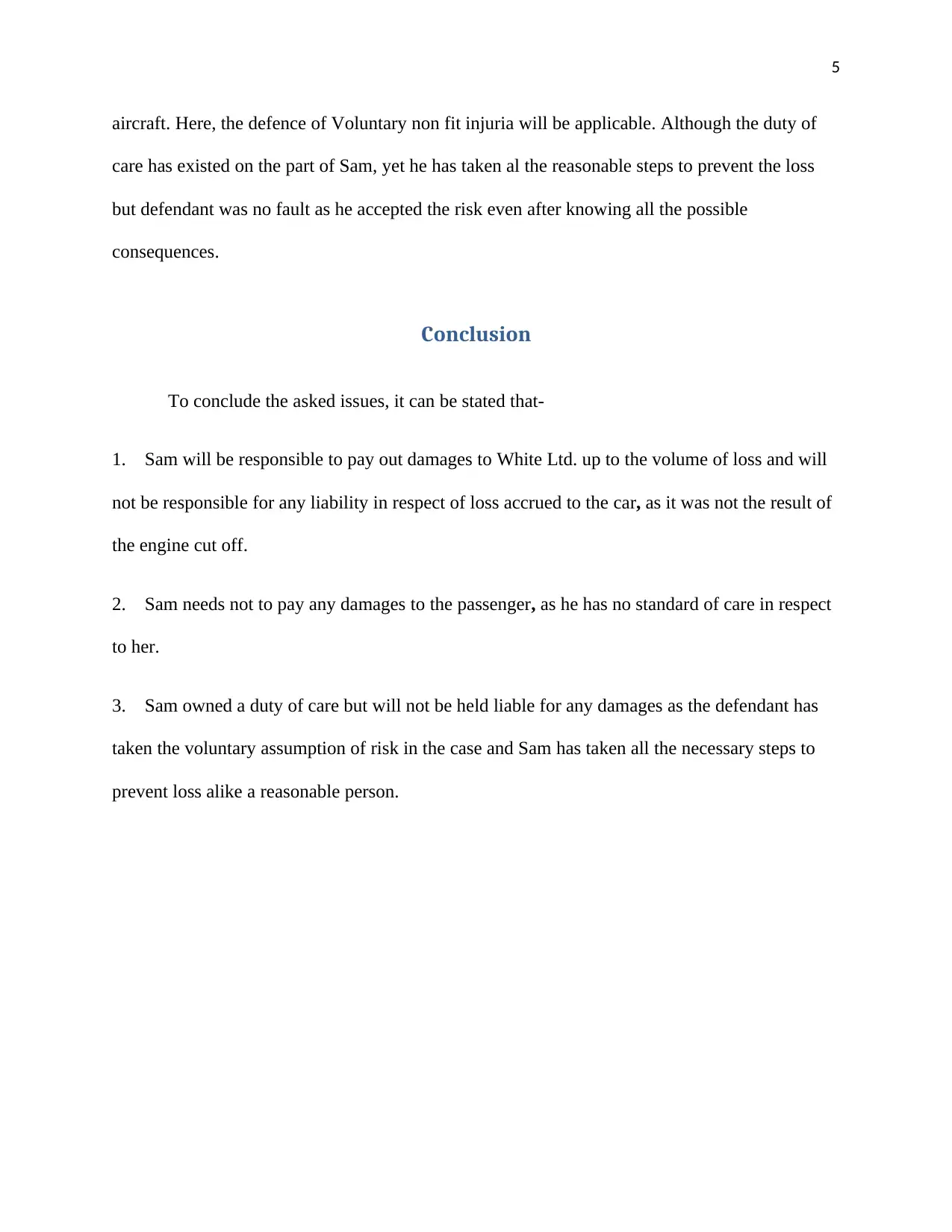
5
aircraft. Here, the defence of Voluntary non fit injuria will be applicable. Although the duty of
care has existed on the part of Sam, yet he has taken al the reasonable steps to prevent the loss
but defendant was no fault as he accepted the risk even after knowing all the possible
consequences.
Conclusion
To conclude the asked issues, it can be stated that-
1. Sam will be responsible to pay out damages to White Ltd. up to the volume of loss and will
not be responsible for any liability in respect of loss accrued to the car, as it was not the result of
the engine cut off.
2. Sam needs not to pay any damages to the passenger, as he has no standard of care in respect
to her.
3. Sam owned a duty of care but will not be held liable for any damages as the defendant has
taken the voluntary assumption of risk in the case and Sam has taken all the necessary steps to
prevent loss alike a reasonable person.
aircraft. Here, the defence of Voluntary non fit injuria will be applicable. Although the duty of
care has existed on the part of Sam, yet he has taken al the reasonable steps to prevent the loss
but defendant was no fault as he accepted the risk even after knowing all the possible
consequences.
Conclusion
To conclude the asked issues, it can be stated that-
1. Sam will be responsible to pay out damages to White Ltd. up to the volume of loss and will
not be responsible for any liability in respect of loss accrued to the car, as it was not the result of
the engine cut off.
2. Sam needs not to pay any damages to the passenger, as he has no standard of care in respect
to her.
3. Sam owned a duty of care but will not be held liable for any damages as the defendant has
taken the voluntary assumption of risk in the case and Sam has taken all the necessary steps to
prevent loss alike a reasonable person.
⊘ This is a preview!⊘
Do you want full access?
Subscribe today to unlock all pages.

Trusted by 1+ million students worldwide
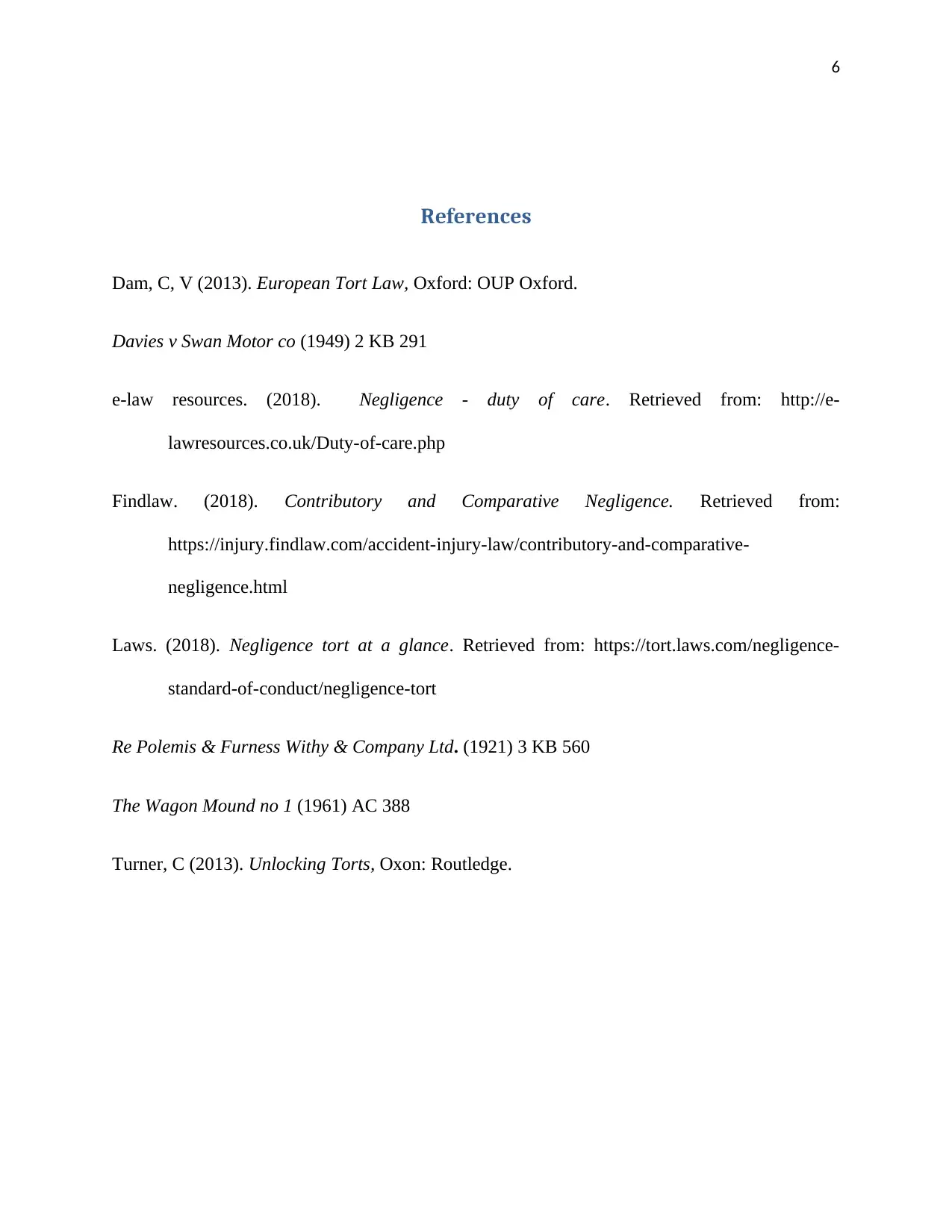
6
References
Dam, C, V (2013). European Tort Law, Oxford: OUP Oxford.
Davies v Swan Motor co (1949) 2 KB 291
e-law resources. (2018). Negligence - duty of care. Retrieved from: http://e-
lawresources.co.uk/Duty-of-care.php
Findlaw. (2018). Contributory and Comparative Negligence. Retrieved from:
https://injury.findlaw.com/accident-injury-law/contributory-and-comparative-
negligence.html
Laws. (2018). Negligence tort at a glance. Retrieved from: https://tort.laws.com/negligence-
standard-of-conduct/negligence-tort
Re Polemis & Furness Withy & Company Ltd. (1921) 3 KB 560
The Wagon Mound no 1 (1961) AC 388
Turner, C (2013). Unlocking Torts, Oxon: Routledge.
References
Dam, C, V (2013). European Tort Law, Oxford: OUP Oxford.
Davies v Swan Motor co (1949) 2 KB 291
e-law resources. (2018). Negligence - duty of care. Retrieved from: http://e-
lawresources.co.uk/Duty-of-care.php
Findlaw. (2018). Contributory and Comparative Negligence. Retrieved from:
https://injury.findlaw.com/accident-injury-law/contributory-and-comparative-
negligence.html
Laws. (2018). Negligence tort at a glance. Retrieved from: https://tort.laws.com/negligence-
standard-of-conduct/negligence-tort
Re Polemis & Furness Withy & Company Ltd. (1921) 3 KB 560
The Wagon Mound no 1 (1961) AC 388
Turner, C (2013). Unlocking Torts, Oxon: Routledge.
1 out of 7
Related Documents
Your All-in-One AI-Powered Toolkit for Academic Success.
+13062052269
info@desklib.com
Available 24*7 on WhatsApp / Email
![[object Object]](/_next/static/media/star-bottom.7253800d.svg)
Unlock your academic potential
Copyright © 2020–2025 A2Z Services. All Rights Reserved. Developed and managed by ZUCOL.



